#biophysics
Text










Green Building, Shiraz, Iran,
Courtesy: Taybe Kazmi
#art#design#architecture#luxury pad#luxury lifestyle#ultimate pad#interior design#luxurypad#concept#render#iran#shiraz#luxury house#luxury home#taybe kazmi#building#green house#biophysics
97 notes
·
View notes
Text
When you're a tiny nematode, electrical fields are positively uplifting. Literally.
The most famous nematode of all – Caenorhabditis elegans – has been caught using electrical fields to its advantage. The tiny worm can somehow piggyback on electrical fields to jump a surprising distance, across a petri dish, for example, or onto the back of a bumblebee for a ride to a new locale.
It's not entirely clear how the nematodes do this, but thanks to an experiment led by biologist Takuya Chiba of Hokkaido University in Japan, it's now apparent that these tiny animals use electrical fields to disperse far afield into new habitats.
"Pollinators, such as insects and hummingbirds, are known to be electrically charged, and it is believed that pollen is attracted by the electric field formed by the pollinator and the plant," says biophysicist Takuma Sugi of Hiroshima University in Japan, co-senior author on the study.
Continue Reading
177 notes
·
View notes
Text
people who work/study in quantitative bio-adjacent fields, rise up. computational neuroscience where you get to see someone's thoughts in feelings in graph form??? so cool. biophysics where you can pass blood plasma through an electric field to determine whether a patient has cancer or not?? unbelievable. biomedical engineering where you can literally build a device to pump someone's heart and be the difference between their life and death??? oh my god. disease modelling, being able to predict AND prevent communities being affected by disease on a large scale through your analysis of data??? i love science
#biomedical engineering#bme#biophysics#healthcare#science academic#chemblr#bioblr#physics#physblr#neuroscience#brains#cell bio#research#sciblr#studyblr
27 notes
·
View notes
Text
How to make sure that nobody steals your favorite box at work.
Put your name on it.
Make it as hideous and infantile as possible so nobody wants to use it.

#science#research#lab#physics#chemistry#women in science#infantile#postdoc#academia#antibiotic research#original content#biophysics
413 notes
·
View notes
Photo
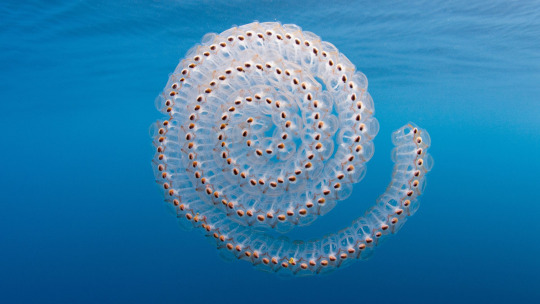
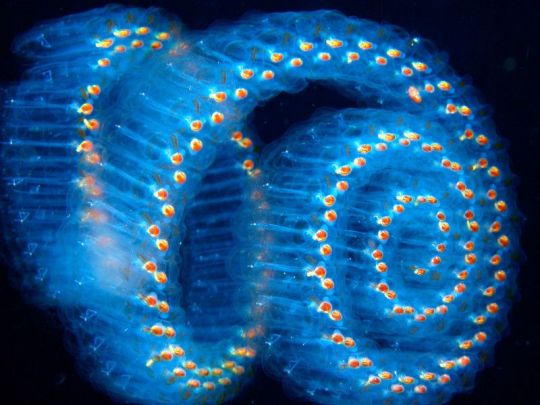



A Salp is a barrel-shaped, planktic tunicate (marine invertebrate animal)
In salp swarms, all the salps are moving in respect to each other such that all the followers move towards the leading salp. In some cases, this behaviour leads to the formation of a spiral shaped colony.
.
Images © Richard Hermann, Chris Vyvyan-Robinson, Kevin Lee
572 notes
·
View notes
Link
124 notes
·
View notes
Text

Growing to Order
Cells organise as they migrate or as tissue grows in ways analogous to liquid crystals. This study provides greater understanding of cell organisation taking into account the influence of adhesion between the cells and with their substrate
Read the published research paper here
Image from work by Julia Eckert and colleagues
Physics of Life Processes, Leiden Institute of Physics, Universiteit Leiden, Leiden, The Netherlands
Image originally published with a Creative Commons Attribution 4.0 International (CC BY 4.0)
Published in Nature Communications, September 2023
You can also follow BPoD on Instagram, Twitter and Facebook
#science#biomedicine#immunofluorescence#cells#liquid crystals#cell migration#cell adhesion#biophysics
12 notes
·
View notes
Text

Wise words from my physics professor today
(On why the large ant at the end of Ant Man would not be able to respire at that size)
25 notes
·
View notes
Text
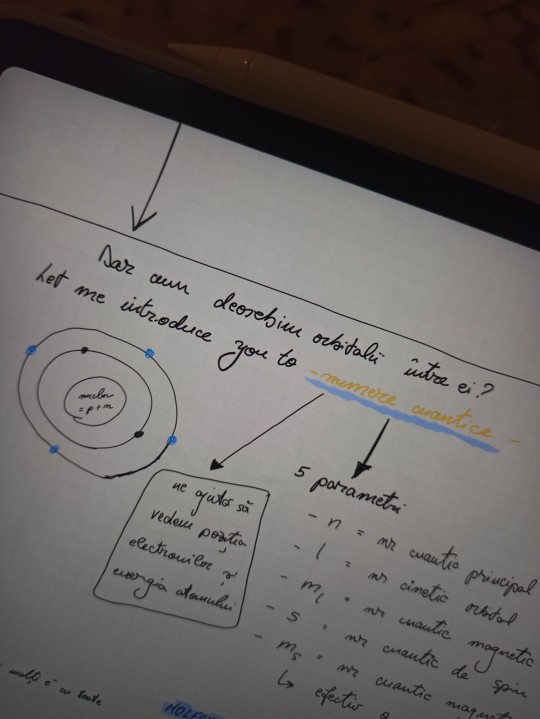


mindmapping is the only way i can learn biophysics
i've never been a science person, but in 11th grade (when i started preparing for the med school admission exam) i developed an interest for chem/bio. however, math and physics were still my enemy :)
≈3 years later, i find them kind of cool, actually! i'm planning on trying to learn the basics of physics this summer. i think it would be cool
#biophysics notes#biophysics#studying for medicine#med school#productive life#being productive#productive#productivity#studying#studyblr#stu(dying)#study motivation#study aesthetic#study hard#medicine#physics#mindmap#study notes
11 notes
·
View notes
Text
I’m a biophysicist and sometimes while reading a paper, i see sentencies that are so far away from everyday-speech that they sound shakespearian to me, i.e.
"the force balance at the protrusion edge, the noisy clutch of retrograde flow, and a response function of friction" (Amiri et al. 2023)
And in my head i was hearing it like Macbeth V,5 monolog
"Life, but a walking shadow, the noisy clutch of retrograde flow that struts and frets upon the stage and then is heard no more"
#biophysics#shakespear et al.#english#language is weird#but also funny#i think it’s just me#macbeth#could have been hamlet
2 notes
·
View notes
Text
Day 2

The more I study for this exam the more I realize I need to study but also the less stressed I feel about it. I just need to keep going.
Finished some practice problems for quantum mechanics. Some were easy, others required me to look at my textbooks from year 1 of undergrad. I’ll be fine, if I keep telling myself that I’ll eventually believe it 🥲
I’ll pass because I have to. No dream is too big ☝️
46 notes
·
View notes
Photo

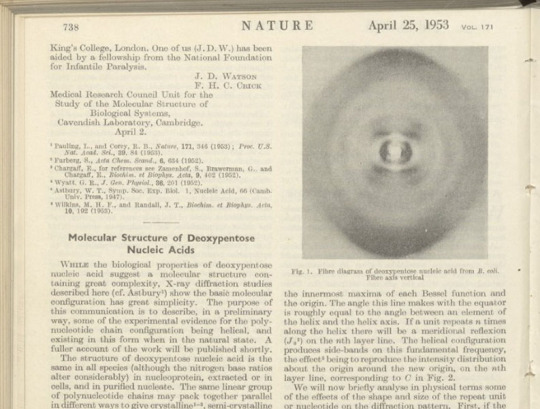



Maurice Wilkins – Scientist of the Day
Maurice Wilkins, a New-Zealand-born English physicist turned molecular biologist, died Oct. 5, 2004, at the age of 87.
read more...
#Maurice Wilkins#biophysics#DNA#X-ray diffraction#histsci#histSTM#20th century#history of science#Ashworth#Scientist of the Day
21 notes
·
View notes
Text
Think of a monarch butterfly, and a distinctive image pops up: black-and-orange wings, with a sprinkling of white spots around the black edges. Those white spots may actually help monarchs complete their long-distance migration by altering the air flow around their wings.
Or, at least, that's the provocative new claim from a team of researchers that has analyzed hundreds of monarch wings collected along its migration route.
"If you have larger white spots, you're simply more successful at reaching Mexico," says Andy Davis, a researcher at the University of Georgia.
He and his colleagues believe that the pattern of color could interact with sunlight to create subtle temperature differences on the wing that can alter airflow, easing the butterflies' flight.
Continue Reading
77 notes
·
View notes
Text

biophysics notes and a coffee;
i suppose i'll have to add the movement of time to my growing list of enemies
#light academia#dark academia#studyblr#coffee#notes#taking notes#study notes#biophysics#medstudent#medschool#study aesthetic
16 notes
·
View notes
Text
There are many postdocs in academia, but not so many permanent researchers.
A new paper shows a statistics on where hundreds of Biomedical Sciences PhD graduates eventually ended up 10 years or more after graduation.
What strikes me there:
1. Sooo many postdocs go to administration positions after their postdoc is finished.
And it's true! I know so many people in administration who were good scientists before!
The following graph shows that from 418 PhD graduates, 325 went for a postdoc and 93 didn't. 145 administration/management/operation (AMO in the graph) positions in the end is for me a bit shocking.
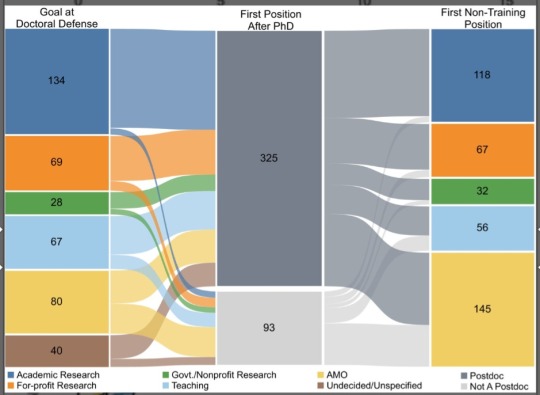
2. The time for a postdoc in academia to actually get a permanent/non trainee position can be up to 13 years!
Only half of the people makes it in 6 years after PhD graduation. That's much longer than getting a permanent job in administration. I do not want to be 13 years postdoc. This is also one of the reasons people quit academia.

There are many more facts in the original article. Go read it if you're interested.
#science#academia#postdoc#career#career goals#industry#administration#career choices#women in science#stem#physics#biology#biophysics#chemistry#statistics#journal article
52 notes
·
View notes
Link
Not for the science-phobic.
Seriously mind-boggling stuff, grounded in solid research.
"What if everything you were told about how the cells of your body get their energy was wrong? What if the body could tap the relatively limitless resources of the Sun directly? Even more astounding, what if the body could tap the infinite energy density of the quantum vacuum and even turn that energy into matter, as well as transform elements into one another? Welcome to the electrifying implications of the New "
~ Sayer Ji
[h/t Ian Sanders]
10 notes
·
View notes